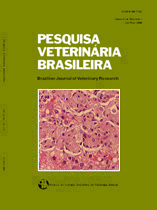 |
|
|
|
Year 2010 - Volume 30, Number 9
|

|
Histologic lesions in livers and lymph nodes in buffalo (Bubalus bubalis) grazing in Brachiaria spp. pastures., 30(9):705-711
|
ABSTRACT.- Riet-Correa B., Riet-Correa F., Oliveira Junior C.A., Duarte V.C. & Riet-Correa G. 2010. [Histologic lesions in livers and lymph nodes in buffalo (Bubalus bubalis) grazing in Brachiaria spp. pastures.] Alterações histológicas em fígados e linfonodos de búfalos (Bubalus bubalis) em pastagens de Brachiaria spp. Pesquisa Veterinária Brasileira 30(9):705-711. Faculdade de Medicina Veterinária, Universidade Federal do Pará, Rua Maximino Porpino da Silva 1000, Castanhal, PA 68743-080, Brazil. E-mail: griet@ufpa.br
Infiltration by foamy macrophages and other lesions are reported in healthy cattle held in Brachiaria spp. pastures. With the objective to study histologic lesions in the liver and mesenteric lymph nodes in buffalo in the state of Pará, samples of liver and lymph nodes of 142 buffalo Murah and 15 Nelore cattle were studied histologically. The samples were collected in an slaughterhouse and divided into groups of animals according to their origin and period of grazing Brachiaria spp. pastures. Group (G) 1 consisted of 79 buffalo from Marajó Island, raised in native pastures free of Brachiaria spp.; G2 was composed of 17 buffalo kept since birth in Brachiaria brizantha pastures; G3 was composed of 29 buffalo purchased in Marajó Island and introduced in B. decumbens pastures where they stayed for nearly 12 months; G4 consists of 17 buffalo purchased in Marajó Island and introduced in B. brizantha pastures where they stayed for nearly 18 months. G5 was composed of 15 Nelore cattle grazing B. brizantha during one year period. To assess the degree of liver injury, grades following a scale of 0 to 4 were established according to the quantity and size of groups of foamy macrophages. In G1, from the Marajó Island, there were no significant histological changes in liver and lymph nodes. Foamy macrophages and other lesions were observed in liver and lymph nodes of all samples from G1, G2, G3, and G4. The animals from G2 and G4, which remained a longer period in Brachiaria spp., showed more pronounced infiltration of foamy macrophages (P<0.05) than the animals of G3. Other lesions observed in the livers of these three groups were swollen, vacuolated or necrotic hepatocytes, mainly in the centrolobular region, and thickening of the Glisson´s capsule with vacuolization and necrosis of subcapsular hepatocytes. These lesions were more pronounced in areas where exists higer infiltration of foamy macrophages. In cattle from G5 smaller groups of foamy macrophages were observed in the lymph nodes and were absent in the liver. These results suggest that the hepatic lesions observed in buffalo are caused by ingestion of Brachiaria spp. The presence of severe lesions in buffalo without clinical signs, much more severe than those observed and reported previously in cattle, as well as the low frequency of Brachiaria poisoning in buffalo grazing in Brachiaria spp. pastures, suggest that buffalo are resilient to Brachiaria spp. poisoning. In each group, there was no association between the weight at slaughter and the degree of lesion. It is also suggested that the observation of severe lesions of the liver, similar to those observed in this experiment, in animal that died from other diseases, can lead to a wrong diagnosis of Brachiaria poisoning. |
| |
|
|
| |
|
 |